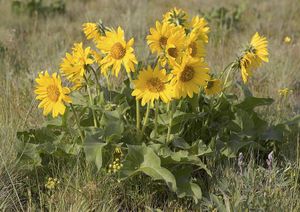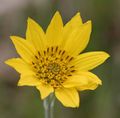Difference between revisions of "Balsamorhiza deltoidea"
(→Description) (Tag: VisualEditor) |
(→Taxonomy) |
||
| Line 17: | Line 17: | ||
| ordo = Asterales | | ordo = Asterales | ||
| familia = Asteraceae | | familia = Asteraceae | ||
| − | | genus = | + | | genus = ''Balsamorhiza'' Nutt. |
| − | | species = | + | | species = ''Balsamorhiza deltoidea'' Nutt. |
| subspecies = | | subspecies = | ||
}} | }} | ||
<br> | <br> | ||
| + | |||
== Description == | == Description == | ||
Revision as of 20:38, 13 March 2021
- Latin Name: Balsamorhiza deltoidea
- Family: Asteraceae
- Common Names: deltoid balsamroot, Puget balsamroot
- Codon: BALDEL
Contents
Taxonomy
| Balsamorhiza deltoidea | |
|---|---|

| |
| Photo by Rod Gilbert, 2005. Also featured on Main Page | |
| Scientific classification | |
| Kingdom: | Plantae |
| Subkingdom: | Tracheobionta |
| Phylum: | Spermatophyta |
| Subphylum: | Magnoliophyta |
| Class: | Magnoliopsida |
| Subclass: | Asteranae |
| Order: | Asterales |
| Family: | Asteraceae |
| Genus: | Balsamorhiza Nutt. |
| Species: | Balsamorhiza deltoidea Nutt. |
Description
Leaves Basal leaves long-stalked, the blades mostly triangular, 10-50 cm long, 10-20 cm wide, green, inconspicuously stiff-hairy and often glandular, prominently nerved, round-toothed; stem leaves few, lanceolate to linear, greatly reduced. Flowers Heads with ray and disk flowers, 1-4, the disk 2.5 cm or more, the lateral heads smaller; involucral bracts lanceolate to oblong-lanceolate, slightly woolly, the outer ones 1-4 cm long and herbaceous, exceeding the inner ones; ray flowers 13 or 21 in a terminal head, yellow, 2-3 cm long; disk flowers 5-7 mm long, yellow. Fruits Achenes glabrous, 7-8 mm long; pappus lacking. Source: The Illustrated Flora of British Columbia.[1]
A plant of woodland openings and open hillsides from California north to British Columbia, where it is listed as an endangered species due to habitat destruction and is found only on the southern shore of Vancouver Island. It does best where fires occur rather regularly; modern suppression of fire has reduced favorable habitat for it.[2]
Bloom Period
March - July[3]
Distribution
Pacific Coast states west of the Cascades. Grows sporadically in dry, open, grassy habitats in the Strait of Georgia, Puget Sound area and south to California, at low elevations.[1]
Habitat
Ecological Setting Salt water shorelines, prairies, meadows, shrub steppe and other open areas at low elevations, mostly in the Puget Sound trough. Soil Texture Prefers deeper soils than most prairie species.[1]
Uses
First Nations Various parts of plant (mostly seeds and roots) used as food by a variety of tribes. Other Root - raw or cooked. A sweet taste when cooked. Young shoots - raw. Seed - raw or cooked. It can be ground into a powder and made into bread. The ground seeds can be formed into cakes and eaten raw. The roasted root is a coffee substitute.
Propagation
Fruit and Seed Collection Shake into bag and do not crush. If the whole stem must be collected, leave several inches of stem and place head down in bag (for small lots of seed collection).[1]
Fruit and Seed Extraction Use the Clipper seed cleaning machine with a medium amount of air flow, through either screen size combinations: 14RD and 6RD, 9RD and 6RD. Discard chaff from port #2 and drawer 3, 4, and 5. Recover the course chaff with seed that did not fall through the top screen (either 14RD or 9RD). Save the very clean seed from main drawer. Take the course chaff/seed and seed that dropped into main tray and re-run through the Clipper once or twice to ensure cleanest seed.[1]
Seed
[[Image:]] Seed sample from: 2011
Average Measurement: 7.5 x 2.5 x 1.9
Measurement Range: L: 6.5 – 8.2, W: 1.6 – 4.5, D: 1.6 – 2
Features
Shape: Seed shapes have lots of variation. Some squared off, and some three sided. Most seeds narrower at hilum than at opposite apex, but not always. Hilum wrinkled. Seeds have circular, white protrusion at apex opposite hilum.
Color: Seeds black, brown, or tan, with white or tan hilum.
Surface: Seeds have some longitudinal ribbing, and are smooth and matte.
Latitudinal Cross Section: some squared [[Image:]], some triangular [[Image:]]
Longitudinal Cross Section: elliptical [[Image:]]Basic Explanations and Assumptions:
The dimensions for the seeds are length x width x depth. The location of the hilum is used as the base of the seed, and the length is measured from hilum to the opposite apex. Where a style is present, the length is measured from the hilum to the bottom of the style. Width is measured at a right angle to the length at the widest part. Depth is measured at a right angle to the intersection of height and width lines.
Measurements included are the mean average for each measurement of ten separate seeds.
All measurements in millimeters unless otherwise noted.
Photo Gallery
References
- ↑ 1.0 1.1 1.2 1.3 1.4 Goodrich, A. (2012). Guidelines of Establishment of Seed Production Sites on Military Installations. Department of Defense Legacy Resource Management Program. Retrieved from https://denix.osd.mil/nr/focus-areas/habitat/habitat-restoration/reports/guidelines-of-establishment-of-seed-production-sites-on-military-installations-final-report-february-2012-legacy-10-326/
- ↑ Native Plants of North America. Retrieved from https://www.wildflower.org/plants/result.php?id_plant=BADE2
- ↑ WTU Herbarium, Burke Museum, & University of Washington. Retrieved from http://biology.burke.washington.edu/herbarium/imagecollection/taxon.php?Taxon=Balsamorhiza%20deltoidea



